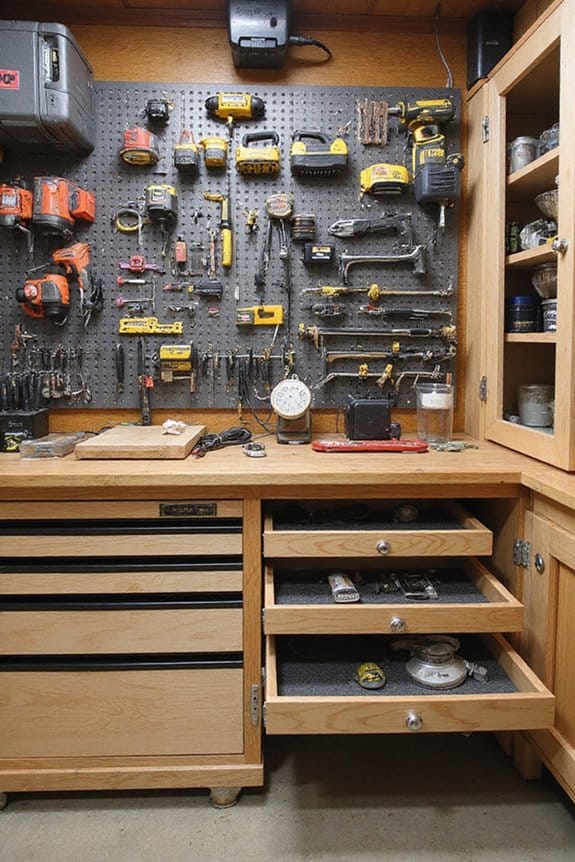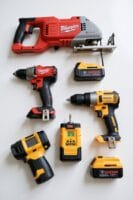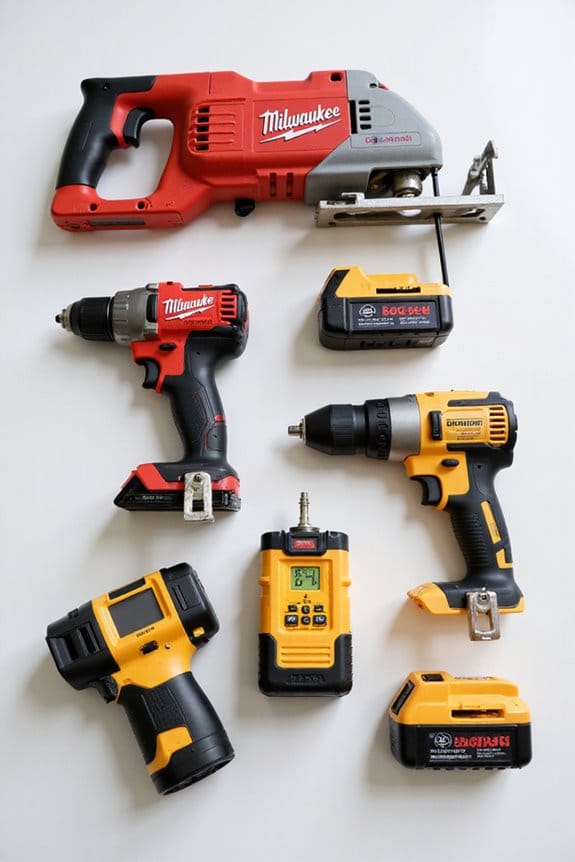Storing power tools properly is essential for keeping them in top shape. First, do a quick check for damage and clean them thoroughly. Next, here’s a simple plan: 1) Store corded tools dry and cords loose; 2) Keep batteries separate and charged at 40-60%; 3) Drain fuel from gas-powered tools; 4) Use containers to organize small parts. Finally, keep everything in a ventilated area at the right temperature, and you’ll be all set! Stick around for some more handy tips!
Key Takeaways
- Conduct a visual inspection of tools for damage and perform functional tests on moving parts before storage.
- Store corded tools in a dry area, wrapping cords loosely to prevent damage.
- Keep cordless tool batteries charged to 40-60% and store them separately in moderate temperatures.
- Utilize clear bins for small accessories, labeling them by type for easy organization.
- Maintain a controlled environment with optimal temperature and humidity to prevent rust and warping.
Pre-Storage Maintenance Essentials

When it comes to storing power tools, a little pre-storage maintenance goes a long way. Trust me; you don’t want to pull out a tool next time only to find it’s in worse shape than you left it! Here’s what I recommend:
- Visual Inspection: Check for cracks, dents, or any visible damage. Don’t forget to look at blades and bits for wear!
- Functional Testing: Test switches and moving parts to guarantee everything operates smoothly. A stuck trigger isn’t what you want.
- Clean Up: Wipe down surfaces and remove any debris. Tools should be dry to prevent rust.
Additionally, ensure that tools made from high-quality materials are properly maintained to extend their lifespan. Keeping your tools in good shape not only saves you money but also keeps your projects running smoothly!
Tool-Specific Storage Requirements
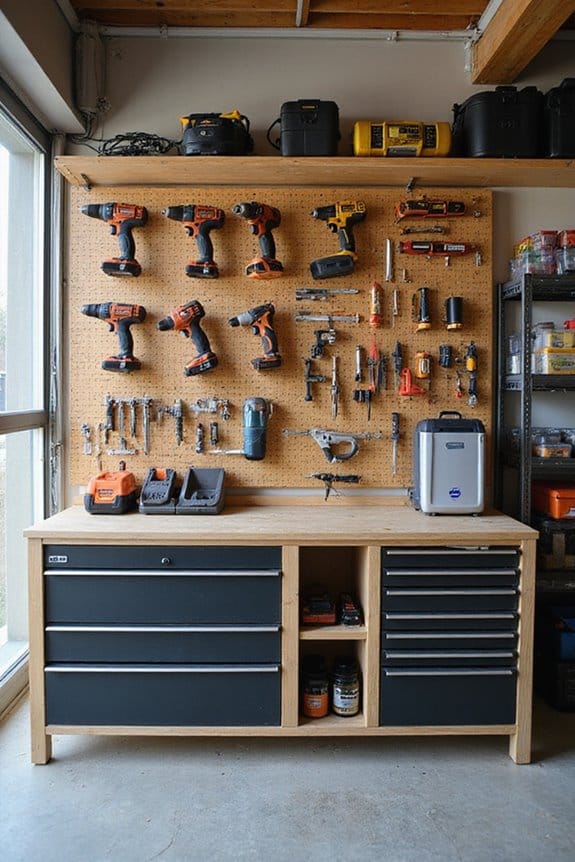
Storing power tools may seem straightforward, but each type has its unique needs. Here’s a quick guide to tool-specific storage requirements:
- Corded Tools: Keep them dry to prevent shorts and corrosion. Wrap cords loosely and store on shelves to avoid damage.
- Cordless Tools: Store batteries separately to avoid drain. Keep them in moderate temperatures and charge them to about 40-60% before storage.
- Fuel-Powered Tools: Drain fuel completely and store in ventilated areas. Use blade guards for safety and place them on lower shelves to prevent falls.
- Small Accessories: Use clear bins for organization. Label them and separate items by type.
- Specialty Tools: Follow manufacturer instructions and use padded cases for delicate parts. Proper storage in a dry, organized space is essential to avoid damage and prolong the life of your tools.
These tailored storage solutions will keep your tools in top shape!
Creating the Ideal Storage Environment
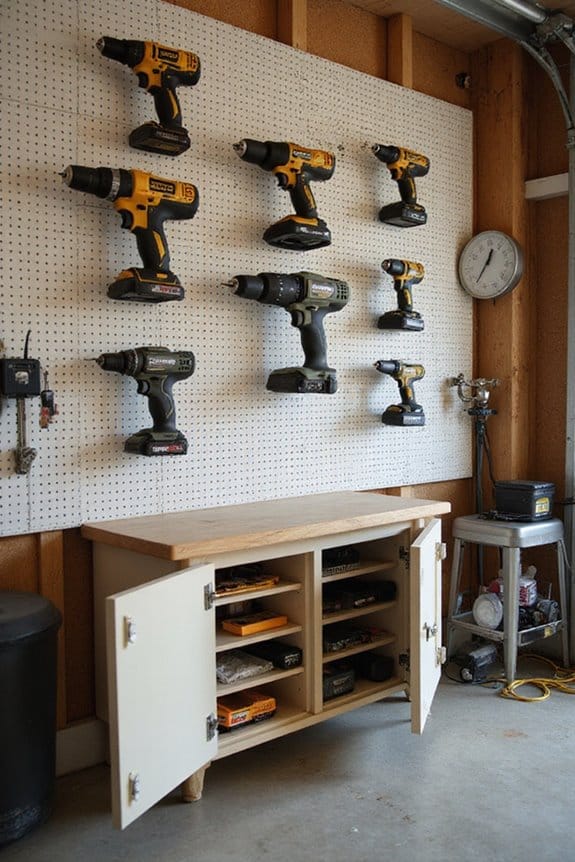
Creating the ideal storage environment for your power tools is crucial, especially if you want them to last. Here’s how I keep my tools in tip-top shape:
- Optimal Temperature: Aim for a stable range between 50°F to 77°F (10°C to 25°C). This helps prevent warping or degradation.
- Humidity Control: Store your tools in a dry, well-ventilated area. Use dehumidifiers or air conditioning if needed, especially in extreme weather.
- Avoid Direct Sunlight: This prevents damage to plastic and rubber components.
- Proper Air Circulation: Maintain good airflow around the tools to prevent condensation.
- Moisture Protection: Use sealed containers and elevate tools off concrete floors to avoid moisture transmission.
Organization and Accessibility Strategies
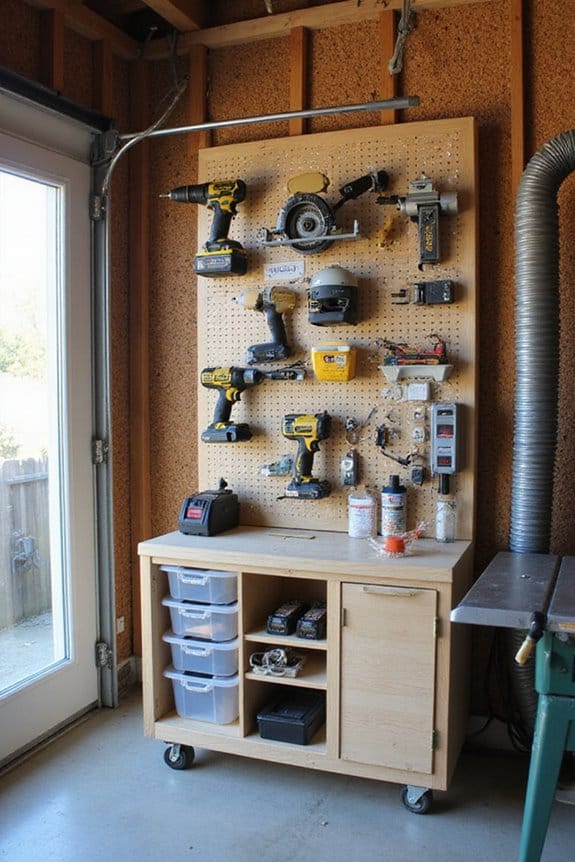
To keep your power tools organized and easily accessible, it’s essential to have a solid strategy in place. Here are a few tips I swear by:
- Tool Categorization: Group similar tools together. It just makes sense!
- Pegboard Integration: Use pegboards for small tools; they offer flexibility and visibility.
- Eye-Level Placement: Store frequently used tools at eye level. You’ll thank yourself later.
- Drawer Utilization: Keep smaller tools in drawers to reduce clutter.
- Labeling Systems: Label bins and drawers for quick access—trust me, it saves time.
- Space Optimization: Don’t forget about vertical space; wall-mounted racks can be a game changer!
Long-Term Care and Safety Measures
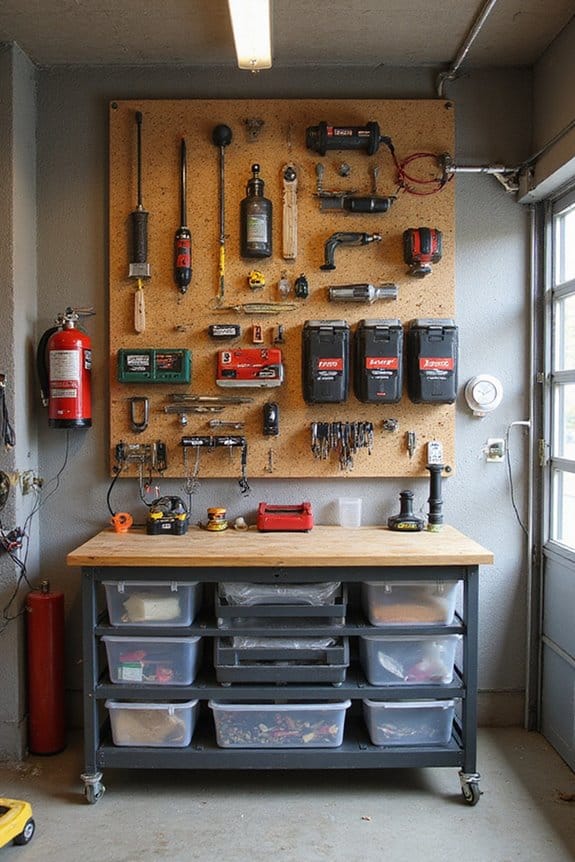
While you might think that storing power tools is a straightforward task, there’s actually a bit more to it if you want to keep them in top shape for years to come. Here are some essential long-term care and safety measures:
- Clean Thoroughly: Remove dirt and moisture to prevent rust. Use compressed air for tight spots.
- Battery Maintenance: Remove batteries from cordless tools and store them in a cool, dry place. Charge them periodically to boost their lifespan.
- Rust Prevention: Apply rust-preventative oil on metal parts, especially after exposure to moisture. Ensuring tools meet regional standards is crucial for maintaining their functionality over time.
- Safety First: Keep tools out of reach of kids and label containers clearly to prevent accidents.
Frequently Asked Questions
Can I Store Power Tools in the Basement?
I often store my power tools in the basement, but I’ve learned to manage the humidity and prioritize tool organization. Proper ventilation and clear containers help keep them safe and in good condition.
How Often Should I Inspect Stored Power Tools?
I check my stored power tools regularly for safety. I recommend a quick inspection before each use, with more detailed checks weekly and thorough inspections monthly. Staying on top of inspection frequency helps guarantee proper tool maintenance.
What Are the Signs of Tool Rust or Corrosion?
I’ve found that rust prevention starts with recognizing the signs of corrosion. Look for flaking, discoloration, or unusual stiffness in tools. If you spot these, timely corrosion treatment can save your tools from significant damage.
Is It Safe to Store Tools in a Shed?
I’ve found that storing tools in a shed can be safe if I prioritize shed organization and tool accessibility. Proper ventilation, security, and protective measures help prevent damage and guarantee I can easily access my tools.
How Do I Prevent Tool Theft During Storage?
To prevent tool theft, I prioritize tool security by using lockable storage, marking my tools, and installing surveillance cameras. It’s essential to stay proactive about theft prevention to protect my valuable equipment from unauthorized access.

